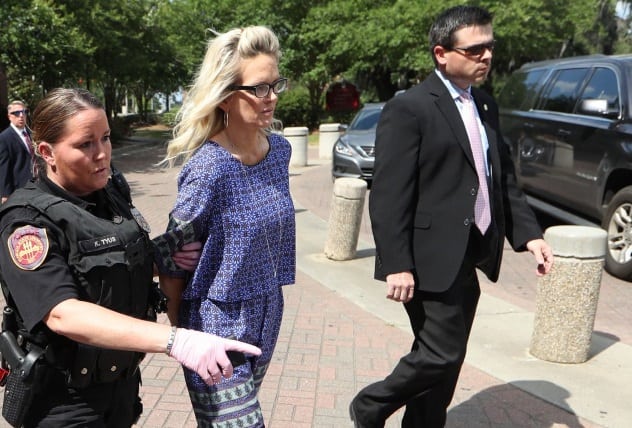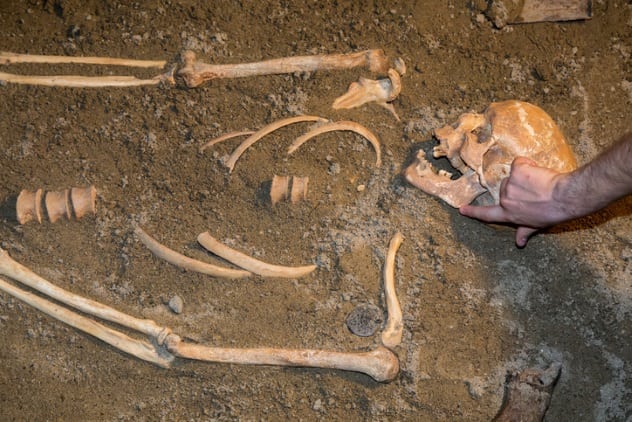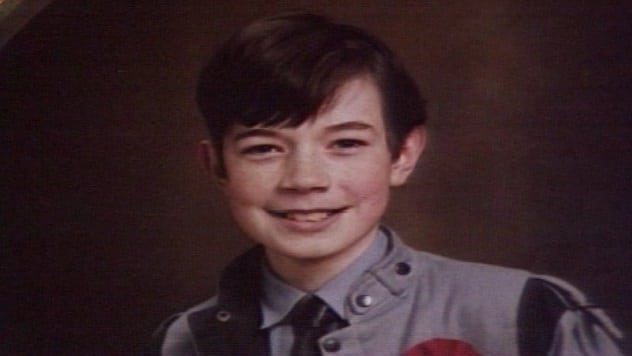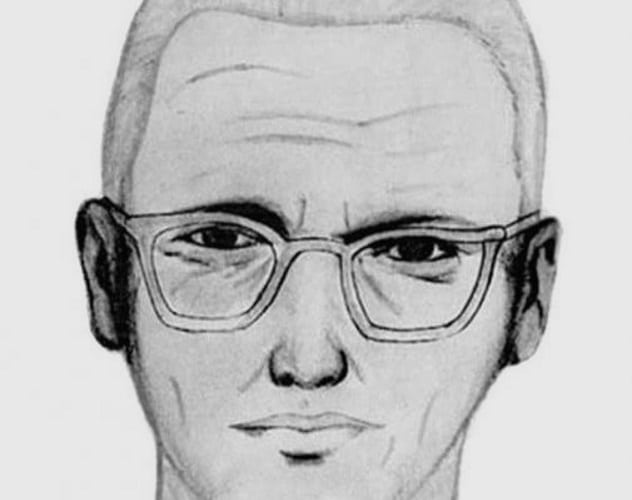 Weird Stuff
Weird Stuff  Weird Stuff
Weird Stuff  Mysteries
Mysteries 10 Tragic Disappearances and Deaths in Joshua Tree National Park
 History
History 10 Ways Childhood Really Sucked in the Old West
 Music
Music 10 Name Origins of Famous Bands from the 1990s
 Religion
Religion 10 Biggest Turnarounds by the Catholic Church
 Weird Stuff
Weird Stuff 10 Unbelievable Times Laws Had Unintended Consequences
 Humans
Humans Ten Historic Women Who Deserve Way More Credit Than They Got
 Movies and TV
Movies and TV 10 Films That Spawned Major Lawsuits
 History
History Ten Times Towns Were Wiped Off the Face of the Earth
 Creepy
Creepy 10 of the Most Disturbingly Haunted Public Houses in the UK
 Weird Stuff
Weird Stuff 10 Niche Subcultures That Are More Popular Than You Might Think
 Mysteries
Mysteries 10 Tragic Disappearances and Deaths in Joshua Tree National Park
 History
History 10 Ways Childhood Really Sucked in the Old West
Who's Behind Listverse?

Jamie Frater
Head Editor
Jamie founded Listverse due to an insatiable desire to share fascinating, obscure, and bizarre facts. He has been a guest speaker on numerous national radio and television stations and is a five time published author.
More About Us Music
Music 10 Name Origins of Famous Bands from the 1990s
 Religion
Religion 10 Biggest Turnarounds by the Catholic Church
 Weird Stuff
Weird Stuff 10 Unbelievable Times Laws Had Unintended Consequences
 Humans
Humans Ten Historic Women Who Deserve Way More Credit Than They Got
 Movies and TV
Movies and TV 10 Films That Spawned Major Lawsuits
 History
History Ten Times Towns Were Wiped Off the Face of the Earth
 Creepy
Creepy 10 of the Most Disturbingly Haunted Public Houses in the UK
Top 10 Grim Cold Cases With Recent Twists And Turns
The wheels of justice turn slowly but grind exceedingly fine. After years, even decades, of investigations with no results, it can seem pretty certain that some cold cases will remain a mystery forever.
That’s not necessarily true, as we’ve recently seen with the Golden State Killer, now tentatively identified as Joseph DeAngelo. Perhaps it will happen through DNA evidence. Perhaps it will happen through the recent practice of searching genealogy databases. It could even happen through dumb luck or unexpected confessions. There are plenty of reasons to hope that the following gruesome cold cases will find their denouements in the near future.
10 Children Killed In Bowraville

The early 1990s saw a string of killings of children in Bowraville, Australia. Four-year-old Evelyn Greenup and 16-year-old Clinton Speedy-Duroux disappeared from the small town in the hinterland of New South Wales and were later found dead from blunt force trauma. A third victim, 16-year-old Colleen Walker, disappeared around the same time and was never found. Her clothes were found in the Nambucca River, weighed down by rocks, and she is presumed dead.
A man named Jay Hart was considered the prime suspect in the Bowraville murders and charged with the slayings of Speedy and Greenup on separate occasions. He was acquitted both times.
In 2006, New South Wales (NSW) changed double jeopardy legislation, allowing retrials of people acquitted of life-sentence offenses as long as there is new, compelling evidence. A decade later, the NSW attorney general applied for a retrial in the Bowraville case. In February 2017, authorities charged a man with the murders.
In accordance with the law, Australian media couldn’t name the accused of the ongoing trial. However, they did say the man had been previously charged and acquitted with two of the murders, leaving little doubt as to his identity. The trial began in November 2017. We don’t know the extent of the new evidence, although it does include witness accounts from two delivery drivers who reportedly saw a man standing over the body of an unconscious Aboriginal teenager on the morning Clinton Speedy disappeared.[1]
9 The Murder Of Dana Bradley

On December 14, 1981, 14-year-old Dana Bradley was hitchhiking in St. John’s, Newfoundland. She disappeared in the evening and was found a few days later in a nearby wooded area. Her body had signs of sexual assault and blunt force trauma. A man confessed to her murder in 1986 but later recanted, and the charges were stayed.
Despite becoming one of the most extensive criminal investigations in Canadian history, there were no substantial leads in the case for almost 35 years. Then two of them came in 2016.
The first was testimony from a man who said he was a witness to the abduction of Dana Bradley. A child at the time, the man, identified as “Robert,” was sitting in the backseat of the car used in the kidnapping, which was being driven by a family friend. He lobbied for the excavation of the vehicle, which had been buried in a landfill for 30 years. The RCMP said they investigated and dismissed the man’s claims. Even so, Robert had supporters who funded the excavation privately in 2016. No usable evidence was found.
Around the same time, Canadian police announced a breakthrough in the form of DNA evidence.[2] They said new tests connected the murder to an unknown suspect. At the moment, they are using them to rule out persons of interest, but it will take a while as the case has generated hundreds of potential suspects over the decades.
8 Cold Case Closed In Orange County

The end of a case doesn’t always give you the satisfaction of feeling like justice was served. This happened a few months ago, when authorities closed the book on the oldest cold case in the history of California’s Orange County.
For 54 years, investigators looked into the murder of 47-year-old Christine Wariner. Her body was found on February 16, 1964, in a room of the now-demolished California Motel in Santa Ana. She had been raped, strangled, and bludgeoned.
The best lead the police had was a bloody handprint on the door, but they only found a match in 2007. Like with many other cold cases, it was a matter of waiting for technology to catch up to the evidence. The print pointed at Charles Edward Faith, a convicted sex offender who would have been in his early twenties at the time.
Slowly but surely, investigators built a case against Faith. Police had the prints and were able to place the accused at the scene of the crime. However, the case never went to court. In 2016, the state dropped the murder charges due to Faith’s failing health.
The district attorney admitted the possibility of the charges being revived if Faith’s health improved. However, that is no longer possible—he died in April 2018.[3] Nobody was ever officially convicted of the crime, but authorities are firmly convinced that the real killer is now beyond reach.
7 The Little Martyr Of The A10

That was the nickname used by French media to refer to a child who was murdered and dumped by the highway near the city of Blois. Police called her Inass. She remained unidentified for almost 30 years. Now, not only do we know who she was, but we might also see justice brought to the killers—her parents.
Still unnamed in the media, the girl was born in Casablanca in 1983. She would have been four years old when her body was discovered covered in a blanket in a ditch along the A10 motorway. She bore signs of gruesome abuse, including broken bones, burns, and even human bite marks. Her murder sparked one of the biggest investigations in the history of France. More than 65,000 schools and 6,000 pediatricians were consulted to try to obtain the victim’s name.
It all went nowhere, and the case was declared unsolved in 1997. Even so, her DNA was added to the national database in 2008, but no matches were found. This changed in 2016, when a man with matching DNA was arrested for an unrelated offense. He turned out to be Inass’s brother.[4]
Police attention turned to their parents, Ahmed and Halima Touloub. Separated in 2010, each one pointed at the other as the violent one who abused the children. Both were arrested in June 2018.
6 A Deadly Love Triangle

Michael and Denise Williams appeared to have a picture-perfect romance. They were high school sweethearts who married in 1994 and settled in Tallahassee, Florida, where Mike found a lucrative job as a property appraiser.
Tragedy struck in December 2000, when Williams went duck hunting on Lake Seminole and never returned. Rescue teams found his abandoned boat but were unable to locate the body. Prevailing theory at that time was that Williams drowned and was eaten by alligators.
There were a few suspicious elements, however. Reptile experts claimed it was too cold for gators to be out hunting. Waders which allegedly belonged to Michael were found months later without any tooth marks. And there was also the life insurance policy worth almost $2 million that Mike Williams had bought from family friend Brian Winchester.
After a few years, Denise married Brian Winchester. In 2012, she filed for divorce. The situation between them got so bad that Winchester kidnapped her at gunpoint. She calmed him down and escaped, but many speculated Brian was planning to commit murder-suicide.
In 2017, Winchester was sentenced to 20 years for the kidnapping, but officials indicated there was some sort of deal in place. Soon afterward, authorities announced they had found the remains of Michael Williams. Denise was arrested in May 2018 and is awaiting trial.
Like many suspected, Winchester confirmed that he and Denise were having an affair and that they killed Mike for the insurance money.[5] While he paints her as the mastermind in all this, Williams’s lawyer insists Winchester acted alone.
5 The Murder Of Milica Van Doorn

One of The Netherlands’ most notorious unsolved cases made a big leap in 2017, thanks to advances in technology as well as the cooperation of the citizens of Zaandam.
In 1992, 19-year-old Milica van Doorn was raped, murdered, and dumped in a pond in the neighborhood of Kogerveld. Multiple witnesses reported a Turkish-looking man cycling near the area. Fast-forward a few decades, and modern technology has allowed scientists to analyze DNA traces left on Milica’s body. They also concluded that her murderer had Turkish ancestry.
Dutch authorities launched what they called a DNA kinship investigation.[6] They identified 133 men of Turkish descent who lived in Kogerveld or had relatives in the area. They were asked to submit, on a completely voluntary basis, a DNA sample. The vast majority obliged. Police stressed that they didn’t consider any of the men to be suspects but were hoping they would be related to the killer.
The new lead proved fruitful. A few weeks later, Dutch authorities announced they arrested a suspect, identified as Huseyin A. He is a man of Turkish ancestry in his late forties who also happened to be one of the few who didn’t voluntarily submit a DNA sample.
4 The West Mesa Bone Collector

In 2009, a woman walking her dog through Albuquerque’s West Mesa stumbled upon the burial site of a serial killer. After an extensive search, investigators found the skeletal remains of 11 women, most of them prostitutes or drug addicts. The killer became known as the Bone Collector.
Officially, nobody was ever charged with the murders. However, in 2018, newly appointed Albuquerque police chief Michael Geier confirmed that their list of suspects was whittled down to two men: Lorenzo Montoya and Joseph Blea.[7]
Lorenzo Montoya lived a few miles from the burial site. In 2006, he strangled a prostitute in his trailer and was shot dead by her pimp. As far as we know, the Bone Collector also stopped killing around the same time.
Joseph Blea became a suspect in the West Mesa murders in 2015 while being investigated for multiple rapes of schoolgirls committed in the 1980s. His DNA had been found on the body of a slain prostitute. He has yet to be charged with any killings, although he received 90 years for the rapes.
One suspect is dead, and the other one will probably spend the rest of his life behind bars. However, Geier doesn’t dismiss the possibility that a third person is the culprit. More importantly, investigators are still searching for a possible second burial site. Six other women with similar lifestyles disappeared between 2005 and 2006 and are feared to be victims of the Bone Collector.
3 The Disappearance Of Philip Cairns

Officially, Philip Cairns is missing. However, as almost 32 years have passed since the 13-year-old vanished while walking home from school in Ballyroan, Dublin, police have long treated it as a child murder case.
Over the decades, investigators have pursued hundreds of leads, but the most promising one arrived in 2016. A woman came forward claiming that Philip had been abducted and murdered by former Radio Dublin DJ Eamonn Cooke. A child herself when it happened, the woman said she was in the car when Cooke picked up the boy and took them both to his radio station. An argument ensued, and the DJ hit Philip with an object. When she saw the boy unconscious and bleeding on the floor, she fainted. She woke up later in the car with Cooke.
When she made these accusations, the disgraced DJ had already been convicted of child sex abuse. However, he was terminally ill and receiving hospice care. Police questioned him, and Cooke was able to confirm some statements made by the woman, but he did not reveal the location of Philip Cairns’s remains.[8]
Cooke died a few months later. Forensic analysis did not find a match between him and DNA traces left on the boy’s schoolbag. However, he has not been dismissed as a suspect.
2 Digging Up Dirty Secrets

During the 1970s, Shirley Finn was a successful brothel keeper in Perth, allegedly operating with the assistance of Western Australian cops and politicians. She was found dead in her car on June 23, 1975. Finn had been shot four times in the head, and her diamond jewelry had not been touched. This was days before a tax hearing where she could have exposed her accomplices.
Given the circumstances, many people believed that Finn was silenced by her partners. The initial investigation lasted less than a year and ended with no arrests. Subsequent inquests yielded the same results.
In 2017, authorities launched a coronial inquest 42 years after the murder. With most of the potential players now dead or in jail, people were more willing to talk. Finn’s former lover, Rose Black, said Shirley went out that night to meet “the Bear.” Another witness clarified that “BJ the Bear” was the nickname of former vice squad chief Bernie Johnson. A third witness said he was threatened at gunpoint by Johnson to keep quiet regarding the case.
There were conflicting testimonies. Two other witnesses placed a woman matching Rose Black’s description at the scene of the crime.[9] Former police officer James Boland, who took part in the original investigation, claimed he had a tip pointing at Sydney gangster Arthur “Neddy” Smith. However, he was told by a superior to “leave it alone.” There were many new leads obtained in a short period of time. It remains to be seen if they will finally close the case.
1 A Renewed Hunt For The Zodiac Killer

The Zodiac Killer is, undoubtedly, one of the most infamous murderers of all time. Active during the late 1960s, most people have given up hope that we will ever find out his identity. However, authorities are looking at the case with renewed zeal following the arrest in another decades-old murder spree, that of the Golden State Killer.
Joseph DeAngelo was identified thanks to genealogical websites. Detectives from the Vallejo, California, police department are hopeful that the same technique can be used for the Zodiac case.[10] They turned to a private lab to obtain a DNA sample from traces of saliva left by the killer on two stamps and envelopes he used to mail letters. We can expect a result this summer.
Detective Terry Poyser specified that Arthur Leigh Allen is a suspect again. For a long time, many investigators considered Allen to be their main candidate for the Zodiac Killer, but he was cleared by a DNA test in 2002. The sample was obtained from the same envelopes, but Poyser mentioned that, back then, they didn’t have the technology to separate the glue from the genetic material and obtain a clean DNA grab. Consequently, they only had a partial sample, with less than half the markers necessary to make a definitive identification.
Read about more fascinating yet terrifying cold cases on 10 Cold Case Confessions That Will Shock You and 10 Haunting Unsolved Cold Cases From New York.








